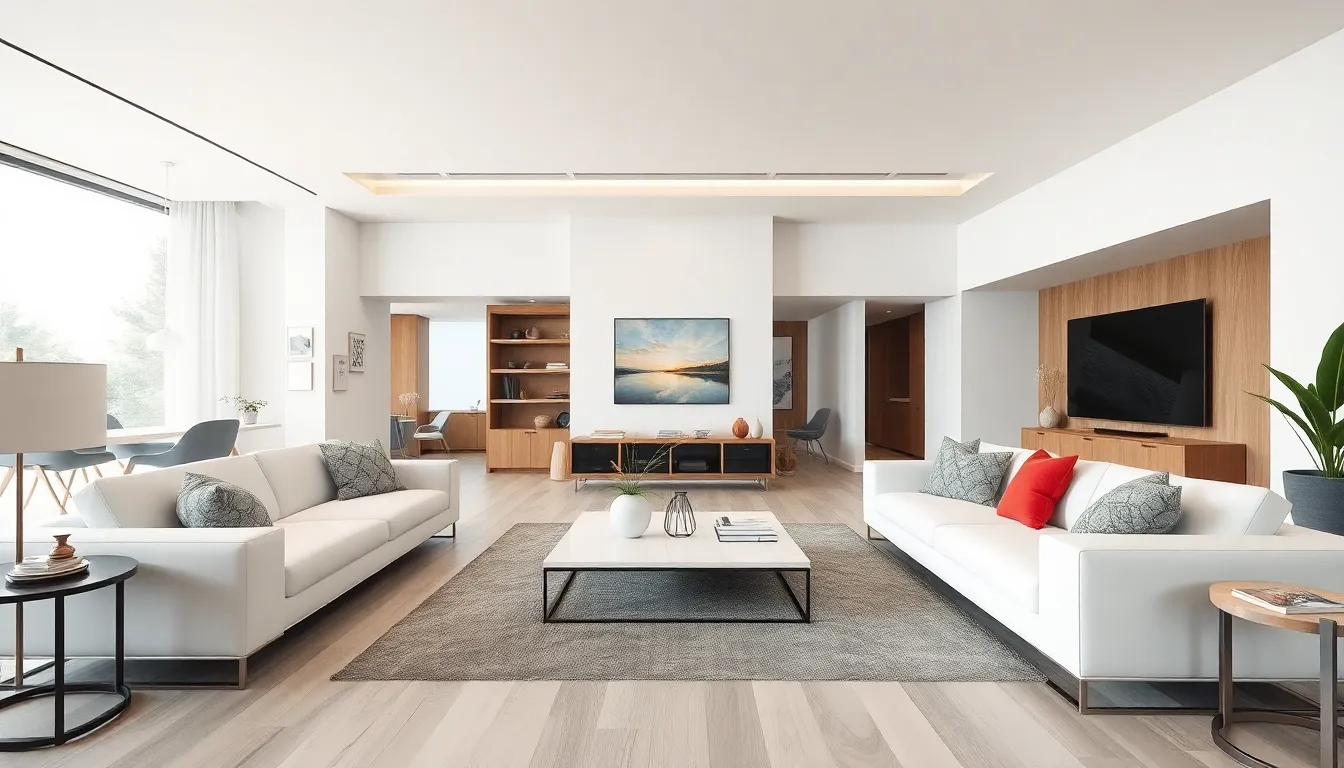Contemporary interior design isn’t just a trend; it’s a lifestyle choice that can turn any dull space into a stylish sanctuary. Imagine walking into a room that feels like it was plucked straight from the pages of a glossy magazine. With clean lines, bold colors, and a dash of whimsy, contemporary design invites creativity while keeping things refreshingly functional.
Table of Contents
ToggleOverview of Contemporary Interior Design
Contemporary interior design emphasizes modern aesthetics, focusing on a blend of style and function. This design approach centers around open spaces and fluid layouts that encourage movement and interaction. Clean lines define furniture and architectural elements, creating a feeling of spaciousness. Bold colors play a crucial role, infusing personality into each area.
Textures, including wood, metal, and glass, combine to create depth and dimension in contemporary spaces. Natural light enhances the overall ambiance, enhancing the visual appeal. Artworks and decorative pieces add subtle accents, allowing for personal expression. Sustainability often guides material choices, reflecting an awareness of environmental impact.
Furniture often features minimalistic designs, prioritizing comfort alongside style. Multifunctionality becomes key, as pieces adapt to various needs. Whether it’s a sleek sofa that doubles as a bed or modular shelving units, versatility remains essential.
Innovative technology finds its place in contemporary interiors, integrating smart home features seamlessly. This incorporation revolutionizes everyday living, offering convenience without sacrificing aesthetic value.
Finally, a subtle whimsy often emerges in contemporary design. Unconventional shapes in furniture or playful color combinations can spark creativity and joy. Each element works cohesively, creating an inviting environment that nurtures both relaxation and inspiration.
Key Characteristics of Contemporary Design

Contemporary design thrives on essential characteristics that blend functionality with aesthetic appeal. Minimalism and simplicity consistently define this style, while color palettes and material choices contribute significantly to the overall atmosphere.
Minimalism and Simplicity
Minimalism expresses itself through uncluttered spaces and sleek lines. Furniture selection emphasizes functionality, often prioritizing pieces that serve multiple purposes. Less is more in this design philosophy, creating environments that feel open and inviting. Clear surfaces remain prevalent, allowing for easy maintenance and a sense of calm. Simplicity also influences decor, with artwork and accessories carefully curated, ensuring every item serves a purpose or evokes an emotional response.
Color Palette and Material Choices
Color palettes in contemporary design often feature neutral tones punctuated by bold accents. Whites, blacks, and grays dominate, forming a sophisticated backdrop for vibrant shades. Natural materials, such as wood and stone, frequently contrast with metals and glass, creating textural interest. Sustainability plays a role in material selection, with designers opting for eco-friendly options wherever possible. Such combinations not only enhance visual appeal but also promote a harmonious balance between nature and modernity.
Popular Contemporary Interior Design Styles
Contemporary interior design encompasses various styles that reflect modern living. Each style brings unique elements while maintaining the core principles of contemporary aesthetics.
Mid-Century Modern
Mid-century modern design features sleek lines and organic forms. Furniture often incorporates materials like walnut and fiberglass, emphasizing simplicity and functionality. Iconic pieces, such as Eames lounge chairs, highlight the comfort and style of this era. This design approach frequently combines bold colors with muted tones, creating harmony in the living space. Open layouts encourage natural light flow, enhancing spaciousness. Integrating vintage accessories can add character and personal touches, making spaces inviting.
Industrial Chic
Industrial chic design captures the essence of urban living. Exposed brick walls and metal beams set the foundation for this style, giving spaces a raw yet sophisticated feel. Large windows promote natural light, further embracing the industrial theme. Furniture often combines reclaimed wood with steel, promoting sustainability. Decorative elements include vintage lighting fixtures and mechanical objects that contribute to the overall aesthetic. Mixing various textures creates visual interest, making each area stand out while retaining a cohesive look.
Scandinavian Influence
Scandinavian design highlights minimalism with a focus on functionality and warmth. Bright spaces often feature light woods, pale colors, and cozy textiles. Clean lines define furniture, enhancing its simplicity and purpose. This style emphasizes natural light, using large windows and open spaces to create a serene environment. Accessories like organic-shaped decor and plants add vibrant touches. Prioritizing sustainability, many designs incorporate eco-friendly materials, fostering a connection with nature.
Elements of Contemporary Interior Design
Contemporary interior design showcases various elements that collectively create modern, inviting spaces. These components enhance the overall aesthetic while prioritizing functionality.
Furniture and Accessories
Furniture plays a pivotal role in contemporary interiors. Pieces exhibit clean lines and smooth surfaces, often embodying a minimalist ethos. Accessories complement the furnishings, adding character without overwhelming the space. Multi-functional items like ottomans with storage or coffee tables that convert into desks illustrate practicality. Textures contribute significantly; smooth metals, natural woods, and soft fabrics each interact to create visual interest. Additionally, statement pieces such as large artworks or sculptural accents provide focal points, encouraging personal expression.
Lighting Trends
Lighting trends in contemporary design emphasize both form and function. Fixtures often feature bold designs, ranging from geometric shapes to organic forms. These elements serve to illuminate while acting as artworks in their own right. Layered lighting enhances depth, with ambient, task, and accent lights creating a dynamic atmosphere. LED options offer energy efficiency without sacrificing style. Natural light also plays a critical role, enhancing mood and highlighting architectural features. By prioritizing these lighting elements, spaces become vibrant and inviting, reflecting the essence of contemporary living.
Contemporary interior design stands as a testament to modern living. It effortlessly combines style and functionality while reflecting personal expression. The emphasis on clean lines and bold colors creates an inviting atmosphere that fosters creativity and comfort.
With its focus on sustainability and innovative technology, this design approach not only enhances aesthetic appeal but also promotes a harmonious relationship with the environment. Each unique style within contemporary design contributes to a rich tapestry of options, allowing individuals to curate spaces that resonate with their lifestyles.
Ultimately, contemporary interior design transforms ordinary spaces into extraordinary experiences, making it a compelling choice for those seeking to elevate their homes.





